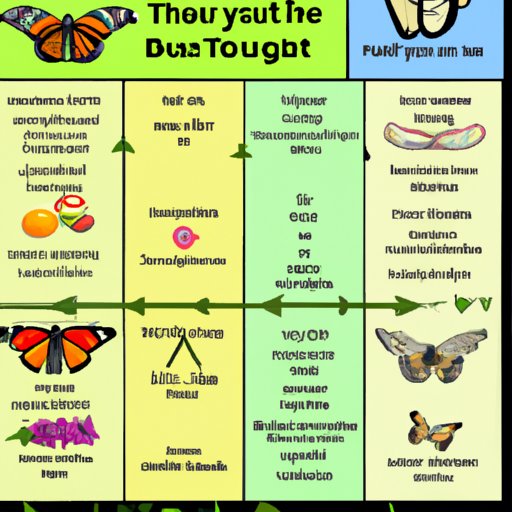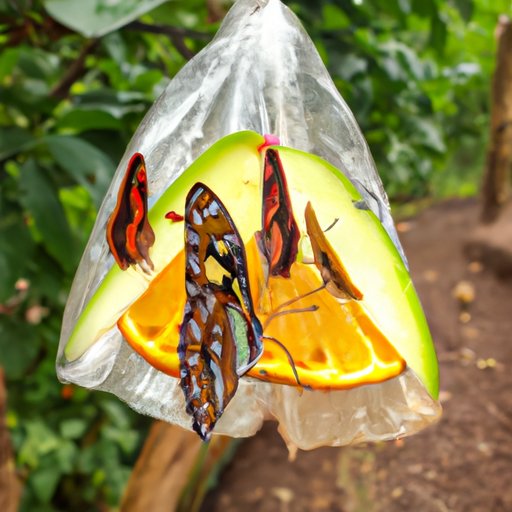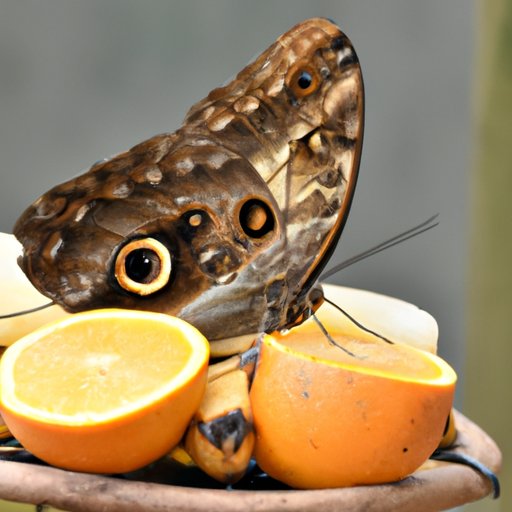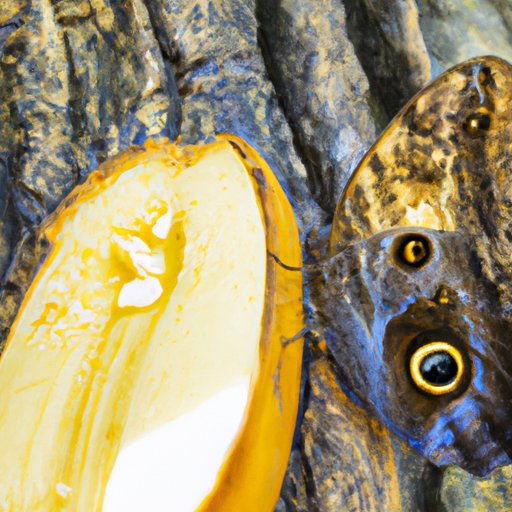Introduction
Butterflies are one of nature’s most captivating creatures. With their vibrant colors and graceful flight, they bring joy to humans and pollinate plants in ecosystems around the world. But what do butterflies eat?
The butterfly diet is varied and complex. In general, adult butterflies feed on the nectar of flowers, but some species also feed on pollen, tree sap, and even rotting fruit. To better understand the needs and behaviors of butterflies, it’s important to explore the different elements of their diet.
This article provides an overview of what butterflies eat and how to best provide them with the nutrition they need. We’ll look at the different types of food they eat, how to attract them with the right diet, and the benefits of a balanced butterfly diet.

A Guide to What Butterflies Eat
Nectar is the primary source of food for adult butterflies. All butterflies feed on nectar, which is a sugary liquid produced by flowers. According to research published in the journal Biological Reviews, “Nectar sugars provide energy for metabolism, thermoregulation, and flight.”
Fruit is another important part of the butterfly diet. Many species of butterflies will feed on rotting or overripe fruits, as well as juices from crushed fruits. This is particularly true of tropical species that may not have access to nectar year-round.
Pollen is another component of the butterfly diet. Adult butterflies will feed on pollen grains, which provide them with protein, vitamins, and minerals. The same Biological Reviews study notes that “pollination mutualisms between flowering plants and butterflies have been reported in numerous cases.”
In addition to these dietary staples, some species of butterflies also feed on tree sap and tree bark. This behavior has been observed in the Mourning Cloak butterfly, which feeds on the sap of trees such as maple, elm, and willow.

How to Attract Butterflies with the Right Diet
To attract butterflies to your garden or outdoor space, it’s important to provide them with the foods they need. Here are a few tips for providing a nutritious diet for butterflies:
Planting Flowers That Produce Nectar
Nectar is the primary source of food for butterflies, so it’s important to plant flowers that produce plenty of it. Some of the best flowers for attracting butterflies include milkweed, marigolds, zinnias, lantana, cosmos, and verbena. These flowers should be planted in sunny areas of your yard to ensure they get enough sunlight to produce nectar.
Creating a Feeder Station
You can also create a feeder station for butterflies by filling shallow dishes with sugar water or fruit juice. Place the dishes near plants that attract butterflies and they will come to drink the sweet liquid. Be sure to change the liquid regularly, as it can spoil quickly.
Supplementing With Fruits
If you want to attract a wider variety of butterflies, you can supplement their diet with fruits. Apples, oranges, and melons are all good choices for feeding butterflies. Simply cut the fruit into small pieces and place it on a plate near the flowers in your garden. The fruit will attract butterflies and other beneficial insects.
What Types of Foods do Different Species of Butterflies Prefer?
Different species of butterflies have different dietary preferences. Here’s a look at what some of the most common species eat:
Monarch Butterflies
Monarch butterflies are one of the most recognizable species of butterfly. They feed primarily on the nectar of milkweed flowers, but they will also feed on other flowers such as thistle, clover, and aster.
Swallowtails
Swallowtail butterflies are another common species. They feed on a variety of flowers, including milkweed, thistle, and clover. In addition, they will feed on the sap of trees such as birch, cherry, and poplar.
Painted Lady Butterflies
Painted lady butterflies are found throughout North America. They feed on a wide range of flowers, including aster, clover, and thistle. They will also feed on the sap of trees such as birches and poplars.

The Benefits of a Balanced Butterfly Diet
Providing butterflies with a balanced diet is essential for their health and wellbeing. A healthy diet can provide a number of benefits, including:
Healthier Butterflies
A balanced diet can help keep butterflies healthier and more resilient to disease. According to a study published in the journal Oecologia, “Nutritional stress can reduce longevity, decrease reproductive output, and increase susceptibility to parasitism and predation.”
Improved Reproduction
A healthy diet can also improve reproduction in butterflies. A study published in the journal Functional Ecology found that “female butterflies that consume high-quality diets show increased rates of oviposition (egg-laying) and egg production.”
Longer Lifespans
Finally, a balanced diet can help butterflies live longer. A study published in the journal Nature Communications found that “butterflies that consume a wide variety of foods live longer than those that feed on a limited diet.”
Which Plants and Flowers are Best for Feeding Butterflies?
When it comes to providing food for butterflies, there are a few key plants and flowers to consider. Here are a few of the best:
Milkweed
Milkweed is a great choice for attracting butterflies, as it produces plenty of nectar. It’s also an important host plant for monarch butterflies, as it’s the only plant on which they lay their eggs.
Marigolds
Marigolds are a popular flower for attracting butterflies, as they produce plenty of nectar. They’re also easy to grow and require little maintenance.
Zinnias
Zinnias are another great choice for feeding butterflies. They produce plenty of nectar and come in a variety of colors, making them a great choice for brightening up your garden.
Exploring the Role of Pollen in a Butterfly’s Diet
Pollen plays an important role in a butterfly’s diet. Pollen provides butterflies with protein, vitamins, and minerals, which are essential for their health and development. It’s also a key component of the pollination process, as butterflies transfer pollen from one flower to another.
Sources of Pollen
Butterflies get their pollen from a variety of sources. They feed directly on the pollen of flowers, as well as on the pollen of fruits and sap from trees. They may also feed on the pollen of mushrooms, which is high in protein.
Nutritional Benefits
Pollen is an important source of nutrition for butterflies. According to a study published in the journal Insects, “Pollen is an important source of proteins and lipids for butterfly larvae and adults.” The study also found that pollen is rich in amino acids, vitamins, and minerals.
Butterfly Nutrition: Understanding What Makes Up a Healthy Diet
Providing butterflies with a healthy diet is essential for their health and wellbeing. Here are a few tips for ensuring a balanced diet:
Variety
It’s important to provide butterflies with a variety of foods. Different species have different dietary needs, so it’s important to offer a range of options. Planting a variety of flowers, providing a feeder station, and supplementing with fruits are all good ways to ensure a varied diet.
Accessibility
Butterflies need easy access to their food. Make sure the flowers and feeders you provide are in areas where butterflies can easily find them. You should also make sure the food is fresh and not spoiled.
Balance
Finally, it’s important to provide a balanced diet. Make sure to provide enough nectar, pollen, and other sources of food to meet the nutritional needs of butterflies. A balanced diet will ensure they stay healthy and active.
Conclusion
Butterflies play an important role in our ecosystems, and providing them with the right diet is essential for their health and wellbeing. Nectar is the primary source of food for adult butterflies, but they also feed on pollen, fruit, sap, and tree bark. To attract butterflies to your garden, plant flowers that produce nectar, create a feeder station, and supplement with fruits. Different species of butterflies have different dietary needs, so it’s important to provide a variety of foods. Finally, a balanced diet is essential for ensuring butterflies stay healthy and active.
We hope this article has helped you gain a better understanding of what butterflies eat and how to provide them with the nutrition they need. For more information on butterfly nutrition, be sure to check out our other articles on the subject.
(Note: Is this article not meeting your expectations? Do you have knowledge or insights to share? Unlock new opportunities and expand your reach by joining our authors team. Click Registration to join us and share your expertise with our readers.)
